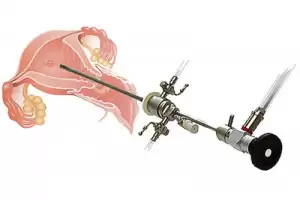Understanding the Procedure, Benefits, and Risks
Hysteroscopy is a medical procedure that allows a gynecologist to examine the uterus using a hysteroscope- a thin tube containing a light camera that relays images of the interior of the uterus. The procedure is used for both diagnosis and treatment of various gynecological conditions, including abnormal vaginal bleeding, infertility, and uterine abnormalities.
The procedure is minimally invasive and usually has few complications when performed by an experienced specialist. If you are considering having a hysteroscopy, it is essential to be well-informed about the procedure, benefits, and any possible risks.
We’ll explore everything you need to know about hysteroscopy to enable you to make an informed decision.
What is Hysteroscopy?
As mentioned earlier, hysteroscopy is a medical procedure that entails visualizing the inside of the uterus using a hysteroscope- a thin tube with a camera and light at the end. This technique allows the gynecologist to view the uterine cavity and detect any abnormalities such as fibroids, polyps, or adhesions.
The procedure can also be used to treat various conditions, including abnormal uterine bleeding, infertility, and endometrial cancer. During the exam, the physician may take a tissue sample for biopsy to rule out or confirm any cancerous growth.
Types of Hysteroscopy
There are different types of hysteroscopy, including the following:
Diagnostic Hysteroscopy
A diagnostic hysteroscopy is done to examine the uterus and detect any abnormalities. This type of hysteroscopy is usually performed in an outpatient setting and does not require anesthesia. The physician inserts a hysteroscope through the vagina and cervix and into the uterus, where they can check the uterus for fibroids, polyps, or any other abnormality.
Operative Hysteroscopy
This type of hysteroscopy is performed to treat or address any issues found during a diagnostic hysteroscopy. The procedure is similar to diagnostic hysteroscopy but may require general or local anesthesia. During the operation, the physician may remove polyps, fibroids, or any other anomalies.
Hysteroscopic Metroplasty
This is a specialized procedure used to treat uterine abnormalities such as septal uteri or bicornuate uteri. The procedure involves removing the septum or extra tissue that separates the two uterine cavities.
Hysteroscopic Myomectomy
This is a type of operative hysteroscopy performed to remove fibroids inside the uterus. In this procedure, the physician first identifies the fibroid’s location and then removes it using a hysteroscope and surgical instruments.
What Happens During a Hysteroscopy Surgery ?
Before the procedure, the Gynecologist will usually give you detailed information about what to expect and any preparation instructions you need to follow. These may include avoiding food or drink for a few hours before the exam, taking pain medication or a sedative, or abstaining from sexual intercourse for a certain period.
During the procedure, you will lie on an examination table with your feet placed at the edge of the table, just like in a regular gynecological exam. The physician will insert the hysteroscope through your vagina and the cervix into your uterus while monitoring the images relayed by the camera.
The physician may also inject a saline solution through the hysteroscope to inflate your uterus, allowing better visualization. This may cause some discomfort or cramping, but medications can help alleviate the discomfort.
After the exam, the physician will remove the hysteroscope and any instruments used, and you will be allowed to rest for a while before being discharged. Most women can return to their regular activities after a few hours, although some may require a bit of rest to recover fully.

Benefits of Hysteroscopy Surgery
Hysteroscopy has several benefits, including:
Accurate Diagnosis
Hysteroscopy allows the physician to visualize the uterus’s interior and detect any issues that may be missed during a pelvic exam or imaging tests. This allows for accurate diagnosis and treatment planning.
Minimally Invasive
Hysteroscopy is minimally invasive, which means it requires only small incisions or no incisions at all. This translates to shorter hospital stays, less scarring, and a quicker recovery period.
Versatility
Hysteroscopy can help identify and treat several conditions, including abnormal uterine bleeding, infertility, and uterine abnormalities. The procedure can also be used for diagnostic and therapeutic purposes.
Risks of Hysteroscopy Surgery
As with any medical procedure, hysteroscopy has some risks. These include:
Infection
Hysteroscopy can introduce bacteria into the uterus, leading to an infection. To reduce the risk of infection, the physician will usually give antibiotics before or after the procedure.
Perforation
In some cases, the hysteroscope may puncture the wall of the uterus, leading to bleeding or injury. This is rare and usually, the physician can resolve the issue immediately.
Bleeding
Hysteroscopy can cause bleeding, especially if performed as an operative procedure. The physician will insert instruments through the hysteroscope to remove the abnormality. If excessive bleeding occurs, the physician may need to terminate the procedure to address the issue.
Reactions to anesthesia
If you are given anesthesia during the procedure, there is a risk of an allergic reaction or other side effects. The physician will discuss the risks and benefits of anesthesia with you before the procedure.
Hysteroscopy is a safe and effective procedure that allows physicians to diagnose and treat various gynecological conditions. If you are experiencing abnormal uterine bleeding, infertility, or other gynecological issues, hysteroscopy may be an option to consider.
Although the procedure has some risks, these are generally rare and can be minimized by choosing a qualified and experienced physician. Speak with your physician about the procedure, any concerns you may have, and how to prepare.
At Dr. Amreen Singh’s clinic, we provide a range of gynecological services, including hysteroscopy. Contact us today to schedule a consultation or to learn more about our services.
Why Dr Amreen Singh for Hysteroscopy surgery in Noida
Hysteroscopy is a medical procedure that is used to observe and examine the inside of a woman’s uterus. It involves the insertion of a thin, lighted tube with a camera on the end, called a hysteroscope, through the cervix and into the uterus. Hysteroscopy is typically used to diagnose and treat various uterine conditions and abnormalities such as fibroids, polyps, and other abnormal growths. Choosing the right doctor for hysteroscopy surgery is crucial to ensure a successful outcome. Dr Amreen Singh, based in Noida, is an experienced and skilled gynecologist who specializes in hysteroscopy and other women’s health issues.
Here are some reasons why Dr Amreen Singh is an excellent choice for hysteroscopy surgery in Noida:
- Expertise and Experience: Dr. Amreen Singh has several years of experience performing Hysteroscopy Surgery procedures. She uses the latest techniques and equipment to ensure that her patients receive the best possible care. She has performed numerous successful hysteroscopy surgeries and is well-equipped to handle complications that may arise during the procedure.
- Patient-Centered Care: Dr. Amreen Singh is known for her compassionate and patient-centered approach to care. She takes the time to listen to her patients’ concerns, answer their questions, and develop a personalized treatment plan that meets their unique needs. She strives to make her patients feel comfortable and at ease throughout the entire process.
- Advanced Technology: Dr Amreen Singh uses advanced technology to ensure precise and accurate diagnosis and treatment of uterine conditions. She uses high-definition cameras and monitors, allowing her to have a better view of the uterus during the procedure. Additionally, she uses lasers and other state-of-the-art equipment to remove any abnormalities detected during the hysteroscopy procedure.
- Multidisciplinary Team: Dr Amreen Singh works closely with a team of specialists, including radiologists, pathologists, and anesthesiologists, to provide comprehensive care to her patients. This multidisciplinary approach ensures that patients receive a thorough evaluation and diagnosis and the best possible care.
- Affordability: Dr Amreen Singh offers affordable hysteroscopy procedures in Noida without compromising on the quality of care. She understands that many patients may be concerned about the cost of medical procedures and works with her patients to help them find affordable solutions.
if you’re looking for a skilled and experienced gynecologist for hysteroscopy surgery in Noida, Dr. Amreen Singh is an excellent choice. Her patient-centered approach, advanced technology, multidisciplinary team, and affordability make her stand out from other providers in the area. Book an appointment today to receive the best possible care for your uterine health.
